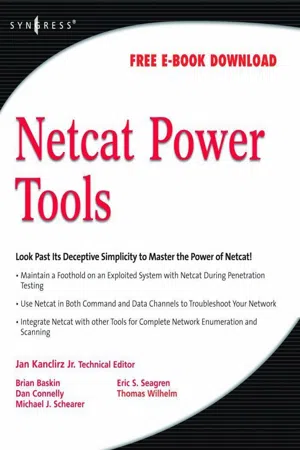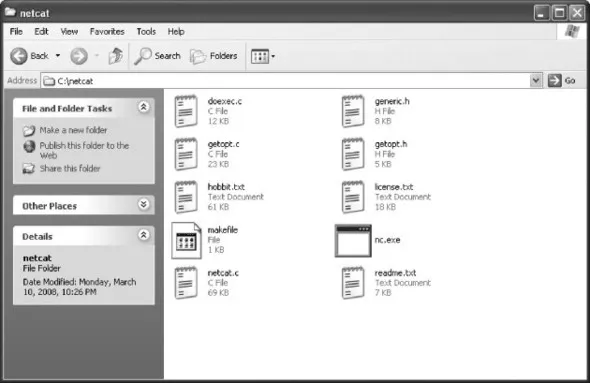
- 280 pages
- English
- ePUB (mobile friendly)
- Available on iOS & Android
Netcat Power Tools
About This Book
Originally released in 1996, Netcat is a netowrking program designed to read and write data across both Transmission Control Protocol TCP and User Datagram Protocol (UDP) connections using the TCP/Internet Protocol (IP) protocol suite. Netcat is often referred to as a "Swiss Army knife" utility, and for good reason. Just like the multi-function usefullness of the venerable Swiss Army pocket knife, Netcat's functionality is helpful as both a standalone program and a backe-end tool in a wide range of applications. Some of the many uses of Netcat include port scanning, transferring files, grabbing banners, port listening and redirection, and more nefariously, a backdoor. This is the only book dedicated to comprehensive coverage of the tool's many features, and by the end of this book, you'll discover how Netcat can be one of the most valuable tools in your arsenal. * Get Up and Running with Netcat Simple yet powerful...Don't let the trouble-free installation and the easy command line belie the fact that Netcat is indeed a potent and powerful program. * Go PenTesting with Netcat Master Netcat's port scanning and service identification capabilities as well as obtaining Web server application information. Test and verify outbound firewall rules and avoid detection by using antivirus software and the Window Firewall. Also, create a backdoor using Netcat. * Conduct Enumeration and Scanning with Netcat, Nmap, and More! Netcat's not the only game in town...Learn the process of network of enumeration and scanning, and see how Netcat along with other tools such as Nmap and Scanrand can be used to thoroughly identify all of the assets on your network. * Banner Grabbing with Netcat Banner grabbing is a simple yet highly effective method of gathering information about a remote target, and can be performed with relative ease with the Netcat utility. * Explore the Dark Side of Netcat See the various ways Netcat has been used to provide malicious, unauthorized access to their targets. By walking through these methods used to set up backdoor access and circumvent protection mechanisms through the use of Netcat, we can understand how malicious hackers obtain and maintain illegal access. Embrace the dark side of Netcat, so that you may do good deeds later. * Transfer Files Using Netcat The flexability and simple operation allows Netcat to fill a niche when it comes to moving a file or files in a quick and easy fashion. Encryption is provided via several different avenues including integrated support on some of the more modern Netcat variants, tunneling via third-party tools, or operating system integrated IPsec policies. * Troubleshoot Your Network with Netcat Examine remote systems using Netat's scanning ability. Test open ports to see if they really are active and see what protocls are on those ports. Communicate with different applications to determine what problems might exist, and gain insight into how to solve these problems. * Sniff Traffic within a System Use Netcat as a sniffer within a system to collect incoming and outgoing data. Set up Netcat to listen at ports higher than 1023 (the well-known ports), so you can use Netcat even as a normal user.
- Comprehensive introduction to the #4 most popular open source security tool available
- Tips and tricks on the legitimate uses of Netcat
- Detailed information on its nefarious purposes
- Demystifies security issues surrounding Netcat
- Case studies featuring dozens of ways to use Netcat in daily tasks
Frequently asked questions
Information
Chapter 1. Introduction to Netcat
- Solutions in this chapter:
- Introduction
- Installation
- Options
- Basic Operations
- Summary
- Solutions Fast Track
- Frequently Asked Questions
Introduction
Note
For the sake of this chapter, we will work with Netcat in two different operating systems: Windows XP and UNIX/Linux. Windows is in a category by itself. The UNIX and Linux variants are essentially the same thing. Furthermore, the differences within the various Linux distributions are minimal. Also be aware that there are at least two slightly different implementations: the original UNIX release of Netcat as well as a more recent implementation called GNU Netcat.
Installation
Windows Installation
Note
Remember that Netcat is a command-line tool. Double-clicking on the nc.exe icon from Windows Explorer will simply run Netcat without any switches or arguments and will present you with a cmd line: prompt. You can run Netcat this way, but once the instance is complete the window will close immediately. This is not very helpful, especially if you want feedback. It is much easier to use from the command line directly. Start | Run | cmd.exe. nc –h will show you the help screen for further guidance.
Are You Owned?
My Anti-virus said Netcat was a Trojan!
Netcat's potent communications ability is not limited to network administrators. Penetration testers use Netcat for testing the security of target systems (for example, Netcat is included in the Metasploit Framework). Malicious users use Netcat (or one of the many variations of it) as a means of gaining remote access to a system. In this sense, it is understandable why many anti-virus programs have labeled Netcat as a “trojan” or a “hacktool.”Some anti-virus programs may try to prevent you from installing Netcat, or even try to prevent you from downloading Netcat or another application that includes Netcat. As with virtually any tool, there is no internal moral compass that limits its use for only legitimate purposes. Your decision in this case is simply to determine if Netcat was purposely downloaded and installed by you (and thus not a threat), or surreptitiously installed by a malicious user for nefarious purposes.You may consider configuring your anti-virus program to exclude a particular directory where you install Netcat when it scans or auto-protects your file system. Of course, you need to be aware of the dangers associated with this.
Figure 1.1. Netcat Installation Under Windows

Linux Installation
Table of contents
- Copyright
- Brief Table of Contents
- Table of Contents
- List of Figures
- List of Tables
- Technical Editor
- Contributing Authors
- Chapter 1. Introduction to Netcat
- Chapter 2. Netcat Penetration Testing Features
- Chapter 3. Enumeration and Scanning with Netcat and Nmap
- Chapter 4. Banner Grabbing with Netcat
- Chapter 5. The Dark Side of Netcat
- Chapter 6. Transferring Files Using Netcat
- Chapter 7. Troubleshooting with Netcat
- Index